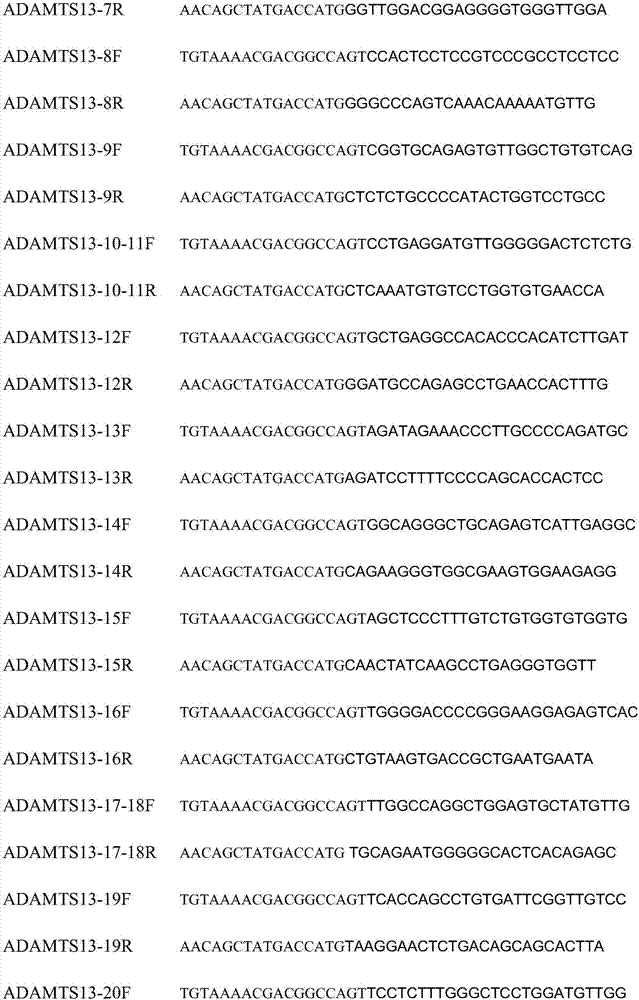Kit and method for detecting whole exomes of ADAMTS13 gene
An all-exome and kit technology, applied in the fields of life sciences and biology, can solve the problems of large ADAMTS13 capacity, multiple mutation types, and prevent in-depth research on ADAMTS13 gene mutations, and achieve low cost, simple operation, and high sensitivity. Effect
- Summary
- Abstract
- Description
- Claims
- Application Information
AI Technical Summary
Problems solved by technology
Method used
Image
Examples
Embodiment 1
[0031] The primers for detecting the full exons of the ADAMTS13 gene include: 26 pairs of forward and reverse primers that amplify and cover the entire exons of the ADAMTS13 gene; the base sequence of the extended primers is:
[0032]
[0033]
[0034]
[0035]
[0036] The primers also include a pair of sequencing primers, the base sequence of which is
[0037] M13-F: TGTAAAACGACGGCCAGT
[0038] M13-R: AACAGCTATGACCATG
[0039] In the detection, first use the above 26 pairs of forward and reverse amplification primers to amplify the DNA fragments covering the entire exon of the ADAMTS13 gene to obtain the amplified product, and then use the above 1 pair of sequencing primers to sequence the amplified product , to obtain the gene sequence of the amplified product.
[0040] In terms of primer design, each pair of primers designed is located on both sides of the exon sequence to be amplified, that is, the amplified region includes the entire sequence of the exon. ...
Embodiment 2
[0048] (1) Extract the genomic DNA in the blood (operate according to the instructions of the blood DNA extraction kit (Tiangen Biology)):
[0049] 1) Take 500ul of blood and add 1000ul of red blood cell lysate, mix by inversion, and let stand at room temperature for 5 minutes, during which time, invert and mix several times. Centrifuge at 3000rpm for 5 minutes, suck off the supernatant, leave the white blood cell pellet, add 200ul buffer GA, shake until thoroughly mixed.
[0050] 2) Add 20 μl proteinase K solution and mix well.
[0051] 3) Add 200 μl buffer GB, mix thoroughly by inversion, place at 70°C for 10 minutes, the solution should become clear, and briefly centrifuge to remove water droplets on the inner wall of the tube cap.
[0052] 4) Add 200 μl of absolute ethanol, vortex and mix well for 15 seconds. At this time, flocculent sediment may appear, and centrifuge briefly to remove water droplets on the inner wall of the tube cap.
[0053] 5) Add the solution and fl...
Embodiment 3
[0083] Eight clinical patient samples were taken, all of which were confirmed to be suffering from TTP, and whether the ADAMTS13 mutation existed in the eight samples was detected. The genome was extracted, reagents were prepared and tested according to the method described in Example 2. Add 2 μl of each sample into the detection system PCR reaction solution. At the same time, make a positive control, a negative control, and a blank control. The test results are as follows:
[0084] The sequencing results of the positive control were compared with the wild-type ADAMTS13 sequence (GeneBank No.: NG_011934.2), and it was found that the two were completely consistent, which proved that the primers used could accurately amplify all the exons of the ADAMTS13 gene. The method of amplification and sequencing is accurate and reliable, and meets the requirements of gene amplification and sequencing.
[0085] The negative control substance and the blank control substance did not produ...
PUM
 Login to View More
Login to View More Abstract
Description
Claims
Application Information
 Login to View More
Login to View More - R&D
- Intellectual Property
- Life Sciences
- Materials
- Tech Scout
- Unparalleled Data Quality
- Higher Quality Content
- 60% Fewer Hallucinations
Browse by: Latest US Patents, China's latest patents, Technical Efficacy Thesaurus, Application Domain, Technology Topic, Popular Technical Reports.
© 2025 PatSnap. All rights reserved.Legal|Privacy policy|Modern Slavery Act Transparency Statement|Sitemap|About US| Contact US: help@patsnap.com



